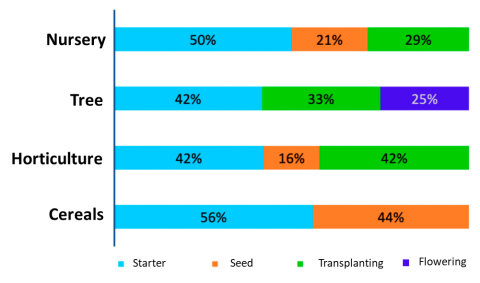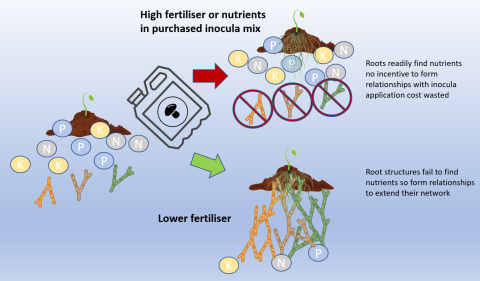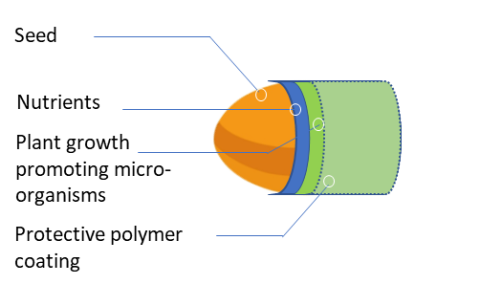1 September 2022
Dr David Cutress: IBERS, Aberystwyth University.
- Mycorrhiza can be added to systems physically via inoculation or encouraged from surrounding environments
- Inoculation strategies should be considered carefully given the ecosystem and climate in which they will be applied or they could act detrimentally or be wasted
- Future research is ongoing to validate inoculation tools for large-scale field use but more needs to be understood about the underlying molecular biology and genetics of mycorrhiza interaction before widespread application can be considered
Mycorrhiza and specifically ‘arbuscular mycorrhizal fungi’ (AMF) and Ectomycorrhiza (EcM) are important symbiotic fungi involved in the successful growth of the vast majority of plant species across the world. We have previously discussed their roles and strategies impacting their activities in an introductory article. The following article aims to expand on this by discussing the different strategies surrounding manipulating these species and the impacts of this on ecosystems, as mycorrhiza are well cited for their strong potential within sustainable food production. Whilst it is agreed that there has been significant growth in the number of industries providing commercial mycorrhiza inocula for gardening, horticulture and agricultural amendment use, the effectiveness of these is subject to debate. Furthermore, additional approaches have been investigated for manipulating plant-mycorrhiza interactions which may be beneficial to consider for future strategies particularly given the outcome desires and funding support suggested in the ‘Sustainable Land Management’ (SLM) proposals.
Inoculations
As a concept, the inoculation of plants/soils with mycorrhiza species should improve the symbiotic benefits which can be achieved through interactions with pasture or crop plant species. Currently, much of the application of inocula relates to their use with starter (applied with seeds) and seed (coated on seeds) planting, as well as any transplanting of plant groups. In agriculture specifically, the most common use surrounds incorporation in cereal strategies as these are our mainstay crops. But we may be limiting their benefits by focusing solely on these systems.
Analysis of where and how mycorrhiza inocula from 68 products across Europe, America and Asia are used - taken from Basiru et al. (2020)
Whilst applying inoculations of mycorrhiza may seem like an obvious and simplistic way to achieve benefits, soil microbiome systems are highly complicated. Applying unknown mycorrhiza species can have knock-on impacts on below-ground ecosystems with unknowable short and long-term effects. In most situations, unless the surrounding landscape is highly degraded such that few or no ‘native’ mycorrhiza remain, utilising local soil inoculants are likely to be more viable, less disruptive and ultimately cheaper (particularly if they can be sourced from your own or nearby land). Essentially self-made inocula can be produced by harvesting soil inclusive of plant root structures from a natively inhabited or long-term productive piece of land. Processing this soil in such a way that root structures are broken down to ~1cm pieces allows the mixture to act as a mycorrhizal inoculate that could be added during the seeding of crops or transplantation. This process functions as mycorrhizal fungi have 3 distinct routes through which they can disperse to propagate in new areas. These include soil-borne spores, mycelial fragments and transfer of colonised root pieces (as is the case in the inoculum described above). These provide the fungi with transfer routes via wind, water as well as animals. As such, when considering the application of mycorrhiza to crops and grasslands for their sustainable benefits it may well be more cost and labour effective to allow natural dispersal routes to do the job for you.
Natural dispersal and inoculation can of course be enhanced and encouraged by providing the right environment. For example, providing a high diversity of plant species increases the likelihood of at least one compatible species being present for mycorrhizae species to form symbiotic relationships with. Utilising locally adapted plants can also help as these are more likely to have efficient locally-adapted mycorrhizal strains nearby. Furthermore, using little or no fertiliser addition will encourage initial symbiotic relationships more readily as plants will have a higher need to scavenge nutrients via interaction with fungi. Whilst this might lead to slower initial productivity, long-term it will lead to far greater nutrient use efficiencies.
Even when using commercial inoculant amendments most of the research suggests that mycorrhizae function more effectively the less fertiliser is applied, so inoculant applications shouldn’t be combined with higher fertilisation strategies. Meta-analyses of 100s of studies suggest this and it is true of both AMF and EcM. The plant groups being used are also important as mycorrhizae have less impact when the plant group is already involved in its own N fixation such as with forbs. The same meta-analysis suggested, that the presence of other non-mycorrhizal microbes (including bacteria and other fungi) improved mycorrhizal benefits on the plants. This suggests that land managers that wish to utilise mycorrhizal inoculations should consider their general soil health before applying mycorrhiza inocula, or they should consider applying total microbiome inoculants alongside these (note: this would naturally occur with locally sourced soil inocula adding benefits to this option).
Problems with commercial inoculants may be the sourcing of the fungi used. Many papers suggest that native mycorrhizal strains are far more effective at adapting and forming symbiotic relationships with native crops and grasses than exotic non-regional strains. In some instances, there is even a suggestion that non-native strains actually impact the microbiome around them negatively which can make overall production drop or become unstable long term. Other studies have directly compared soil-based native inoculations to commercially available inoculations and suggested that local soil inocula worked well as an inoculation strategy, better than commercial varieties in almost all aspects. It has also been highlighted that there are non-symbiosis impacts associated with some commercial inocula suggesting that some of the benefits seen with these commercial varieties may be due to the substrate containing nutrients (N, P, K etc), effectively acting as a boost of fertiliser, rather than due to the mycorrhizae actively integrating alongside the plant species. These findings were echoed across other meta-analyses with the same general trends found. Furthermore, it was highlighted that larger effects of mycorrhizal inoculation were found in studies where soils were already highly degraded and lacking in rich microbiome diversity. Similarly, it is suggested that soil inocula outperformed commercial/experimental inocula even when commercial inoculations contained a higher diversity of mycorrhizal strains suggesting that buying a mycorrhizal mix isn’t a quick fix to these issues.
Delivery strategies
Some interesting future considerations in development for boosting the effectiveness of soil inoculations involve looking at the delivery mechanisms of the mycorrhizal fungi to the plants in soils. Alongside issues surrounding inoculations discussed above, there is also research suggesting poor survival rates of inocula in storage, transport and in soils due to environmental and other factors. One approach that could combat this is seed coating, which is already a technique being used commercially to protect seeds, making them easier to plant (due to manipulating weight and size) and to incorporate growth promotion via combining with nutrients and microorganisms for example. Seed coating can also reduce the inocula application dosages needed compared to solid and liquid amendments, as they are protected from environmental losses. To take this further some interesting experimentation surrounding nano-particle inclusion in seed coating strategies has shown the ability to reduce inoculant dosages by 97% whilst maintaining growth benefits and could make resource efficiency even better in the future. Overall, benefits have been shown in reviews for seedling establishment, germination and improving yields with lower nutrient fertilisers applied, but it is still noted that a better understanding of soil microbiome interactions is needed in many situations to ensure such strategies function in situ in fields.
Summary
Mycorrhiza manipulation and considerations are likely to become increasingly important when considering future sustainable agricultural production practices. Whilst there are currently a large number of gaps in our knowledge with regards to specific interactions dependent on factors such as plant species, mycorrhiza species, abiotic factors and biotic factors. There is a wealth of research suggesting some general trends of functionality which are useful to understand. Local inoculants or allowing native nearby mycorrhizal systems to propagate naturally currently seems more viable than commercial inoculants in all but the most extreme scenarios. A summary of the considerations surrounding the use of mycorrhiza inoculation is as follows;
If you would like a PDF version of the article, please contact heledd.george@menterabusnes.co.uk



